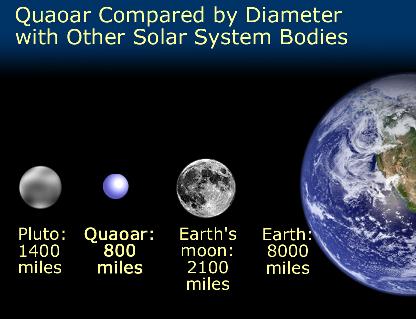Discovered in June of 2002, Quaoar is a large Kuiper Belt object roughly a billion miles beyond the orbit of Pluto, and although its size is still controversial, the best estimates make it out to be about half Pluto’s diameter. Think of the Kuiper Belt as something similar to the Asteroid Belt, though containing up to 100 times more material. The region is critical to our understanding of the early Solar System because it seems to contain the System’s most primitive materials. The fact that temperatures in the Kuiper Belt are as low as -50 K tells us that ices existing there should have been preserved since the dawn of planetary formation.

Now a new study reporting near-infrared observations of Quaoar has revealed the presence of crystalline water ice and ammonia hydrate. Both, according to a letter by astronomers David Jewitt and Jane Luu that has just appeared in Nature, are peculiar. Crystallinity indicates that the ice has been heated to at least 110 K, and both water ice and ammonia hydrate should have been destroyed by radiation over the time scales we are talking about. The upshot: “We conclude that Quaoar has been recently resurfaced, either by impact exposure of previously buried (shielded) ices or by cryovolcanic outgassing, or by a combination of these processes.”
Source: “Crystalline water ice on the Kuiper belt object (50000) Quaoar,” Nature 432, 731 – 733 (09 December 2004). More on the Kuiper Belt can be found at the Kuiper Belt Homepage. Quaoar has a page of its own created by its discoverers, Chad Trujillo and Mike Brown at Caltech.
Image credit: NASA and A. Field (STSci).

